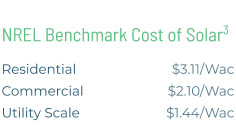Dramatic cost reductions in wind and especially solar power seem to promise a distributed energy future. Grid-connected rooftop solar lets any home or industrial facility become a “prosumer” that produces electricity as well as consuming it. In developing countries, solar lanterns, solar home systems, and perhaps solar mini-grids provide energy when grid access is unavailable or unaffordable.
Meanwhile, traditional power utilities struggle to adapt to a high-renewables world. New high-voltage transmission lines are desperately needed to carry electricity from the regions with the best wind and solar resources to the places where the most people live. Utilities’ financial models are under stress as renewable energy incentives lead their best customers to “opt out” of high retail electricity rates in favor of installing distributed solar.
Could distributed renewable energy be ushering in a “small is beautiful” era of power supply that dispenses with the need for big power plants, big interconnected grids, and big utilities?
Limitations of small and dispersed renewable energy
The reality is closer to the opposite. The characteristics of wind and solar energy mean we need scale and connectivity more than ever. Larger, more interconnected wind and solar installations usually beat out smaller, more isolated ones on the following dimensions:
WIND + SOLAR ENERGY MEAN WE NEED SCALE AND CONNECTIVITY MORE THAN EVER
- Supply variability. For an isolated wind or solar generator, energy output varies substantially according to instantaneous local weather and time of day. Integrating many generators into a geographically larger grid tends to smooth out variations. Larger grids also facilitate co-integration of wind and solar generators, taking advantage of the fact that resources may not be correlated in time and space.1
- Cost and availability of storage and backup generation. The intermittent character of wind and solar means they need some combination of storage and backup generation to provide power whenever it is needed. For small, isolated systems, this usually means expensive batteries or diesel generators. Systems embedded in larger grids, by contrast, tend to have access to backup generation from other sources on the grid as well as cost-effective storage options like pumped hydro.
- Demand variability. Individual consumers can vary significantly in their demand for energy within the day and across days. Averaging many consumers together across a larger grid reduces the “peakiness” of the demand profile that energy generators have to serve. This is an advantage of any large grid, but it is particularly valuable when a high share of energy comes from intermittent renewable energy. Dynamic pricing of electricity to end consumers can create incentives for them to reduce demand when wind and solar resources are unavailable. And these pricing programs will likely prove more cost-effective to implement across larger grids and service territories due to economies of scale.
- Ability to deliver high peak power of high quality. Certain home appliances like electric stoves and irons draw high power. Trying to run such appliances off an isolated solar home system would require oversizing panels and batteries, dramatically increasing cost. Large industrial operations have even more need for high peak power, delivered reliably and with high quality. For the moment, at least, renewables can only help meet this need in the context of a large interconnected grid with the ancillary services to maintain quality and reliability.

- Cost of renewable energy. There are important economies of scale when it comes to wind and solar installations. For example, wind turbines are employing larger and larger diameter rotors to boost capacity factor and reduce installation cost.2 Large solar farms can supply cheaper energy than smaller rooftop facilities due to efficiencies in land acquisition, permitting, and installation.3 Wind and solar farms in interconnected grids can be optimally located in the regions with the best renewable resources, with the energy transmitted to population centers via high-voltage, low-loss transmission lines. All of these factors lower the cost per unit of energy produced.
Distributed renewables have a niche, but large and connected is usually best
Distributed renewables can fill an important gap where modern grid-based power is not available or affordable because of local institutions or geography. Distributed systems may also provide unique value in areas of high population density where it is difficult to build more transmission lines and generation.
Yet, the popularity of distributed renewable systems often reflects specific policy incentives rather than the underlying calculus of how to maximize renewable generation for a given investment. For example, even though utility-scale solar is more cost-effective than rooftop residential solar in California, net metering and high retail rates for consumers make rooftop solar financially attractive to households, especially wealthier ones that consume more electricity.
Small has its niche, but if the goal is maximizing the potential of wind and solar energy, big is beautiful.
Endnotes
- Frank A. Wolak, “Level versus variability trade-offs in wind and solar generation investments: The case of California,” The Energy Journal 37(SI2), 2016.
- David Roberts, “These huge new wind turbines are a marvel. They’re also the future.” Vox, May 20, 2019
- Ran Fu,David Feldman, and Robert Margolis. 2018. U.S. Solar Photovoltaic System Cost Benchmark: Q1 2018. Golden, CO: National Renewable Energy Laboratory. NREL/TP-6A20-72399.
